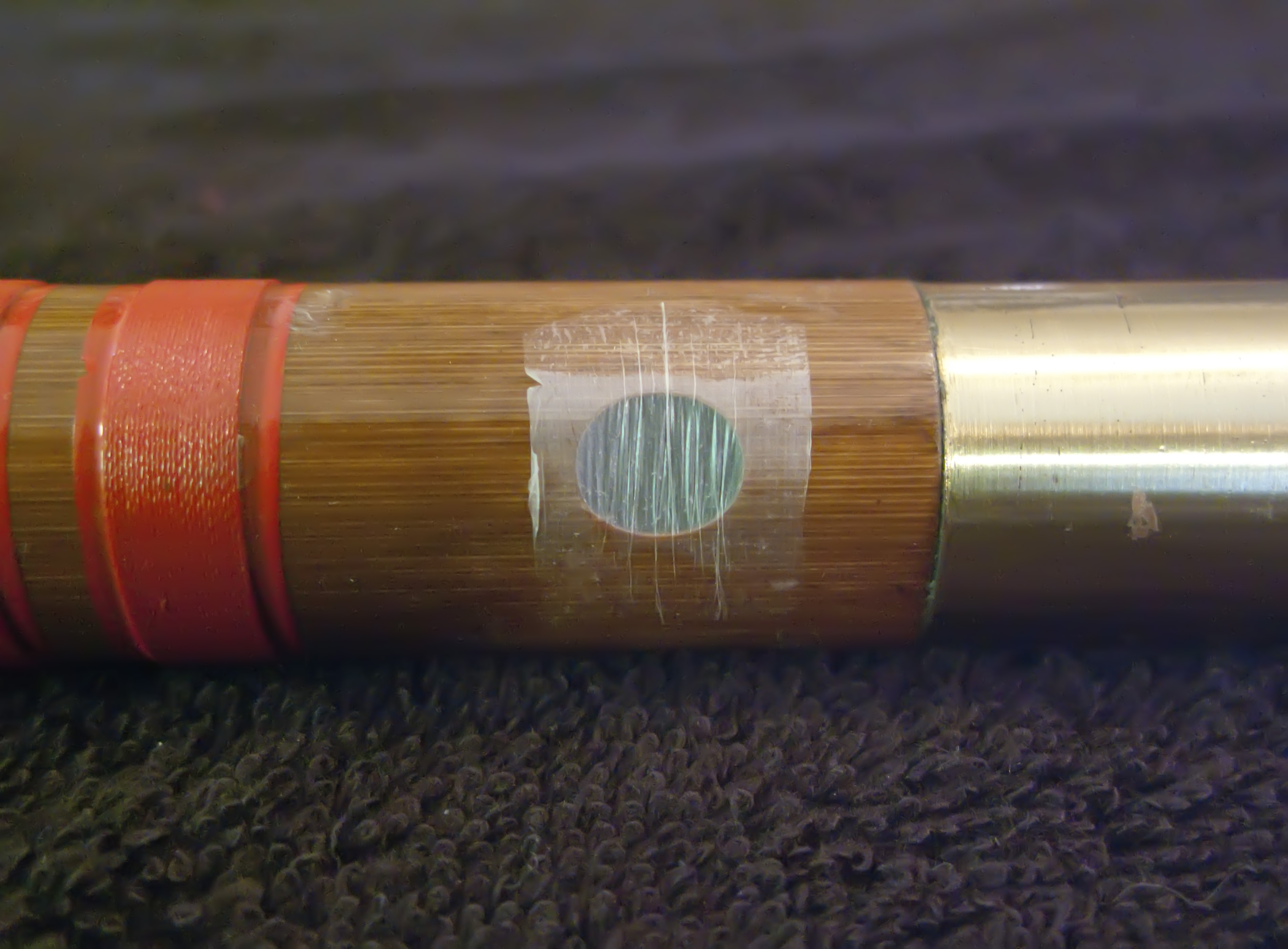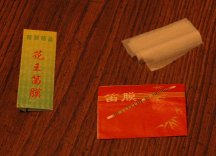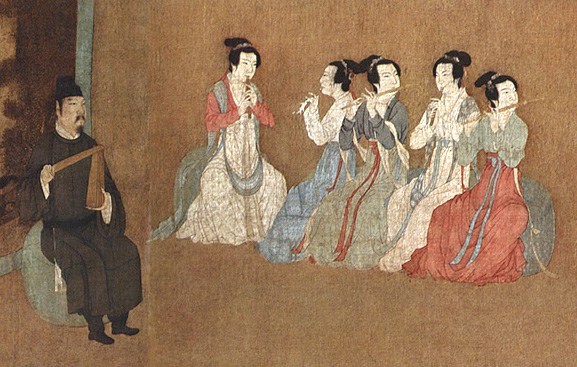|
Xindi (instrument)
The ''xindi'' (; literally "new flute") is a Chinese musical instrument. A 20th-century derivative of the ancient '' dizi'' (bamboo transverse flute), the ''xindi'' is western influenced, fully chromatic, and usually lacks the dizi's distinctive ''di mo'', or buzzing membrane. The xindi is also known as the 11-hole di ( 十 一 孔 笛). Its design is western influenced and based on the principal of equal temperament. It first appeared in the early 1930s. It was designed and produced by Ding Silin (丁西林1893-1974). Characteristics and range The biggest difference between the xindi and the traditional Chinese di is that there are an additional five finger-holes compared to the six found on the di. Additionally, it has three more finger-holes than the Xiāo ( 簫) - an eight-hole flute which, itself, has extra finger-holes compared to the di, for the right little finger and left thumb. The additional finger-holes on the xindi are for the right-hand thumb, the little finger of t ... [...More Info...] [...Related Items...] OR: [Wikipedia] [Google] [Baidu] |
Musical Instrument
A musical instrument is a device created or adapted to make musical sounds. In principle, any object that produces sound can be considered a musical instrument—it is through purpose that the object becomes a musical instrument. A person who plays a musical instrument is known as an instrumentalist. The history of musical instruments dates to the beginnings of human culture. Early musical instruments may have been used for rituals, such as a horn to signal success on the hunt, or a drum in a religious ceremony. Cultures eventually developed composition and performance of melodies for entertainment. Musical instruments evolved in step with changing applications and technologies. The date and origin of the first device considered a musical instrument is disputed. The oldest object that some scholars refer to as a musical instrument, a simple flute, dates back as far as 50,000 - 60,000 years. Some consensus dates early flutes to about 40,000 years ago. However, most historians be ... [...More Info...] [...Related Items...] OR: [Wikipedia] [Google] [Baidu] |
Di Mo
The ''dimo'' () is a special membrane applied to the transverse Chinese flute called '' dizi'' (or ''di''), giving the instrument its characteristic buzzing timbre. ''Dimo'', made from the tissue-thin membrane from the interior of a specific variety of bamboo, are supplied as tubular sleeves. Only a small rectangle is needed at a time, so for application, a small section is cut off the end of the ''di mo'' sleeve, and that small tube is cut open to make a rough rectangle of flat membrane. The Korean transverse bamboo flute called ''daegeum'' has a similar buzzing membrane. The Korean ''sogeum'' and ''junggeum'', Vietnamese ''sáo'', and the Thai ''khlui'' also once had membranes, but these are not used today. Application The ''di mo'' is applied to the membrane hole (or Mo kong) of the dizi using a special, traditional glue called ''Ejiao''. One of the advantages of ''ejiao'' is that the glue is water-soluble, so that it can be wetted again to re-adjust the ''di mo''. After ... [...More Info...] [...Related Items...] OR: [Wikipedia] [Google] [Baidu] |
Chinese Orchestra
The term Chinese orchestra is most commonly used to refer to the modern Chinese orchestra that is found in China and various overseas Chinese communities. This modern Chinese orchestra first developed out of Jiangnan sizhu ensemble in the 1920s into a form that is based on the structure and principles of a Western symphony orchestra but using Chinese instruments. The orchestra is divided into four sections – wind, plucked strings, bow strings, and percussion, and usually performs modernized traditional music called ''guoyue''. The orchestra may be referred to as ''Minzu Yuetuan'' () or ''Minyuetuan'' () in mainland China, ''Chung Ngok Tuen'' () in Hong Kong, ''Huayuetuan'' () in Southeast Asia, or ''Guoyuetuan'' () in Taiwan, all meaning Chinese orchestra. The term modern Chinese orchestra is sometimes used to distinguish the current form from ancient Chinese orchestras that existed since the Shang dynasty and was used in royal courts and later during Confucian ceremonies. Anc ... [...More Info...] [...Related Items...] OR: [Wikipedia] [Google] [Baidu] |
Western Concert Flute
The Western concert flute is a family of transverse (side-blown) woodwind instruments made of metal or wood. It is the most common variant of the flute. A musician who plays the flute is called a flautist (in British English), flutist (in American English), or simply a flute player. This type of flute is used in many ensembles, including concert bands, military bands, marching bands, orchestras, flute ensembles, and occasionally jazz bands and big bands. Other flutes in this family include the piccolo, the alto flute, and the bass flute. A large repertory of works has been composed for flute. Predecessors The flute is one of the oldest and most widely used wind instruments. The precursors of the modern concert flute were keyless wooden transverse flutes similar to modern fifes. These were later modified to include between one and eight keys for chromatic notes. "Six-finger" D is the most common pitch for keyless wooden transverse flutes, which continue to be used to ... [...More Info...] [...Related Items...] OR: [Wikipedia] [Google] [Baidu] |
Dizi (instrument)
The ''dizi'' (, pronounced ), is a Chinese transverse flute. It is also sometimes known as the ''di'' () or ''héngdi'' (), and has varieties including Qudi (), Bangdi (), and Xindi (instrument), Xindi (). It is a major List of Chinese musical instruments, Chinese musical instrument that is widely used in many genres of Music of China, Chinese folk music, Chinese opera, as well as the modern Chinese orchestra. The ''dizi'' is also a popular instrument among the Chinese people as it is simple to make and easy to carry. Most ''dizi'' are made of bamboo, which explains why ''dizi'' are sometimes known by simple names such as Chinese bamboo flute. However, "bamboo" is perhaps more of a Chinese instrument classification like "woodwind" in the West. Northern Chinese ''dizi'' are made from purple or violet bamboo, while ''dizi'' made in Suzhou and Hangzhou are made from white bamboo. ''Dizi'' produced in southern Chinese regions such as Chaozhou are often made of very slender, lightweig ... [...More Info...] [...Related Items...] OR: [Wikipedia] [Google] [Baidu] |
Qudi
The ''dizi'' (, pronounced ), is a Chinese transverse flute. It is also sometimes known as the ''di'' () or ''héngdi'' (), and has varieties including Qudi (), Bangdi (), and Xindi (). It is a major Chinese musical instrument that is widely used in many genres of Chinese folk music, Chinese opera, as well as the modern Chinese orchestra. The ''dizi'' is also a popular instrument among the Chinese people as it is simple to make and easy to carry. Most ''dizi'' are made of bamboo, which explains why ''dizi'' are sometimes known by simple names such as Chinese bamboo flute. However, "bamboo" is perhaps more of a Chinese instrument classification like "woodwind" in the West. Northern Chinese ''dizi'' are made from purple or violet bamboo, while ''dizi'' made in Suzhou and Hangzhou are made from white bamboo. ''Dizi'' produced in southern Chinese regions such as Chaozhou are often made of very slender, lightweight, light-colored bamboo and are much quieter in tone. Although ba ... [...More Info...] [...Related Items...] OR: [Wikipedia] [Google] [Baidu] |
Timbre
In music, timbre ( ), also known as tone color or tone quality (from psychoacoustics), is the perceived sound quality of a musical note, sound or musical tone, tone. Timbre distinguishes different types of sound production, such as choir voices and musical instruments. It also enables listeners to distinguish different instruments in the same category (e.g., an oboe and a clarinet, both Woodwind instrument, woodwind instruments). In simple terms, timbre is what makes a particular musical instrument or human voice have a different sound from another, even when they play or sing the same note. For instance, it is the difference in sound between a guitar and a piano playing the same note at the same volume. Both instruments can sound equally tuned in relation to each other as they play the same note, and while playing at the same amplitude level each instrument will still sound distinctively with its own unique tone color. Experienced musicians are able to distinguish between diff ... [...More Info...] [...Related Items...] OR: [Wikipedia] [Google] [Baidu] |
Key (music)
In music theory, the key of a piece is the group of pitches, or scale, that forms the basis of a musical composition in classical, Western art, and Western pop music. The group features a '' tonic note'' and its corresponding ''chords'', also called a ''tonic'' or ''tonic chord'', which provides a subjective sense of arrival and rest, and also has a unique relationship to the other pitches of the same group, their corresponding chords, and pitches and chords outside the group. Notes and chords other than the tonic in a piece create varying degrees of tension, resolved when the tonic note or chord returns. The key may be in the major or minor mode, though musicians assume major when this is not specified, e.g., "This piece is in C" implies that the key of the song is C major. Popular songs are usually in a key, and so is classical music during the common practice period, around 1650–1900. Longer pieces in the classical repertoire may have sections in contrasting keys. ... [...More Info...] [...Related Items...] OR: [Wikipedia] [Google] [Baidu] |
Dizi (instrument)
The ''dizi'' (, pronounced ), is a Chinese transverse flute. It is also sometimes known as the ''di'' () or ''héngdi'' (), and has varieties including Qudi (), Bangdi (), and Xindi (instrument), Xindi (). It is a major List of Chinese musical instruments, Chinese musical instrument that is widely used in many genres of Music of China, Chinese folk music, Chinese opera, as well as the modern Chinese orchestra. The ''dizi'' is also a popular instrument among the Chinese people as it is simple to make and easy to carry. Most ''dizi'' are made of bamboo, which explains why ''dizi'' are sometimes known by simple names such as Chinese bamboo flute. However, "bamboo" is perhaps more of a Chinese instrument classification like "woodwind" in the West. Northern Chinese ''dizi'' are made from purple or violet bamboo, while ''dizi'' made in Suzhou and Hangzhou are made from white bamboo. ''Dizi'' produced in southern Chinese regions such as Chaozhou are often made of very slender, lightweig ... [...More Info...] [...Related Items...] OR: [Wikipedia] [Google] [Baidu] |
Octave
In music, an octave ( la, octavus: eighth) or perfect octave (sometimes called the diapason) is the interval between one musical pitch and another with double its frequency. The octave relationship is a natural phenomenon that has been referred to as the "basic miracle of music," the use of which is "common in most musical systems." The interval between the first and second harmonics of the harmonic series is an octave. In Western music notation, notes separated by an octave (or multiple octaves) have the same name and are of the same pitch class. To emphasize that it is one of the perfect intervals (including unison, perfect fourth, and perfect fifth), the octave is designated P8. Other interval qualities are also possible, though rare. The octave above or below an indicated note is sometimes abbreviated ''8a'' or ''8va'' ( it, all'ottava), ''8va bassa'' ( it, all'ottava bassa, sometimes also ''8vb''), or simply ''8'' for the octave in the direction indicated by placing ... [...More Info...] [...Related Items...] OR: [Wikipedia] [Google] [Baidu] |
Semitone
A semitone, also called a half step or a half tone, is the smallest musical interval commonly used in Western tonal music, and it is considered the most dissonant when sounded harmonically. It is defined as the interval between two adjacent notes in a 12-tone scale. For example, C is adjacent to C; the interval between them is a semitone. In a 12-note approximately equally divided scale, any interval can be defined in terms of an appropriate number of semitones (e.g. a whole tone or major second is 2 semitones wide, a major third 4 semitones, and a perfect fifth 7 semitones. In music theory, a distinction is made between a diatonic semitone, or minor second (an interval encompassing two different staff positions, e.g. from C to D) and a chromatic semitone or augmented unison (an interval between two notes at the same staff position, e.g. from C to C). These are enharmonically equivalent when twelve-tone equal temperament is used, but are not the same thing in meantone temper ... [...More Info...] [...Related Items...] OR: [Wikipedia] [Google] [Baidu] |





.jpg)


